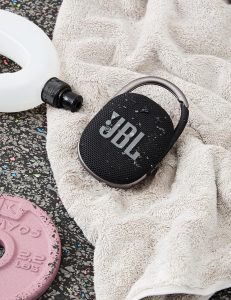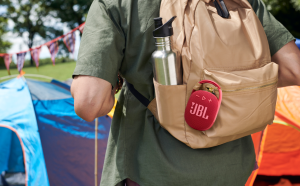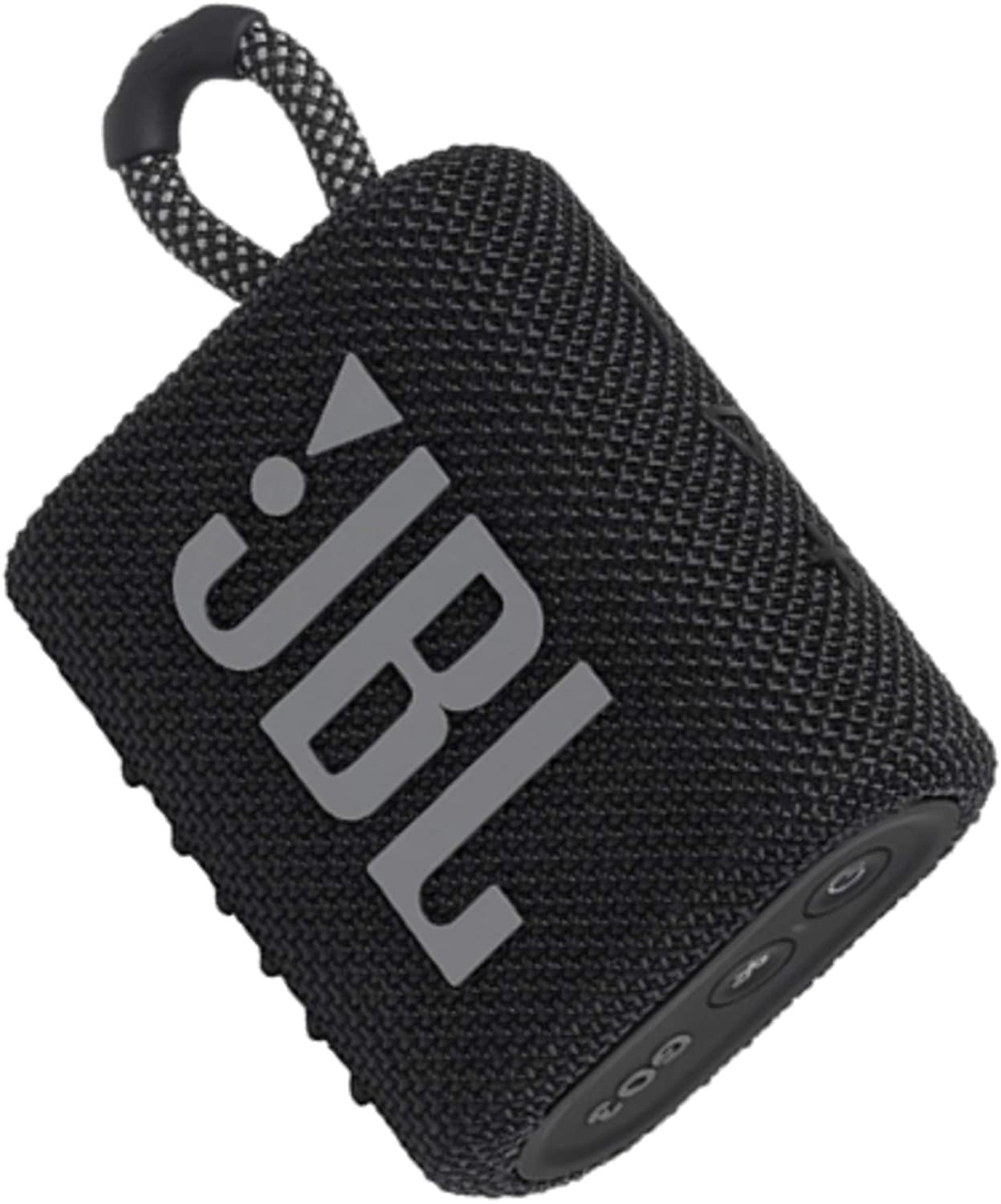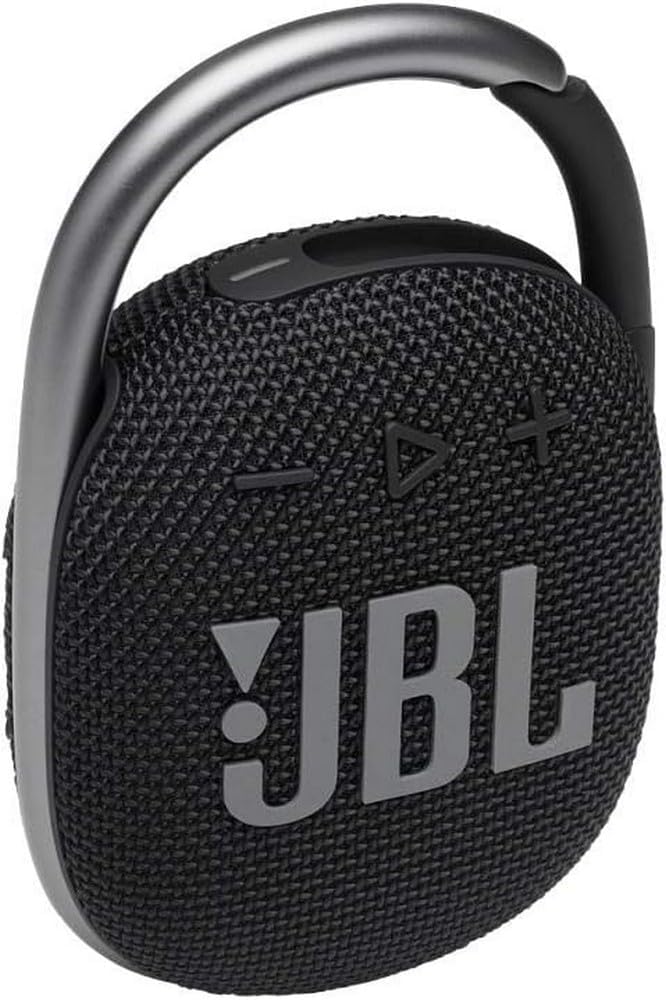|
Top sales! JBL GO 3
Dimensions: 8.6 x 6.9 x 4 cm |
Our recommendation! JBL Clip 4
Dimensions: 8.6 x 13.5 x 4.6 cm |
JBL’s range of speakers is one of the highest quality in the sound technology market; In fact, JBL is one of the most reputable brands today. Even when designing and marketing “pocket” speakers. Today we want to focus on the company’s smallest portable speakers, to see what the differences are between them and which one is more worth buying. We are talking, of course, about the JBL GO 3 and JBL Clip 4.
The first thing that stands out is that they have a totally different design. The JBL GO 3 has a rectangular shape and a flat base that makes it standable. On the other hand, the JBL Clip 4 is oval and does not have that flat base. Instead, it has a more solid carabiner that makes it easier to hook it to our backpack or bag. The JBL GO 3 also has a attachment clip, but smaller.
Another of the most important differences between the two wireless speakers is the autonomy, since the JBL Clip 4 doubles the time during which it can work compared to the GO 3. Likewise, it has a slightly higher power and a frequency response whose range is a little wider. The result is that the JBL Clip 4 offers higher sound quality, especially in bass sounds.
However, there are not only differences between the two speakers; There are also numerous similarities. For example, both have the same level of resistance to water and dust. Both have Bluetooth connectivity, but are not compatible with WiFi or the JBL app. In addition, they do not integrate functionalities such as PartyBoost or JBL Connect+, as happens with other more advanced speakers from the brand. Therefore, if you want to know how to choose the most suitable one for you, keep reading!
JBL GO 3 vs JBL Clip 4 – Comparison Table
If you are hesitating and don’t know which speaker to buy, we show you a comparison so you can see what the main differences are between these two models. Later, we will explain them in detail:
JBL GO 3
|
JBL Clip 4
|
|
| Dimensions | 8,6 x 6,9 x 4 cm | 8,6 x 13,5 x 4,6 cm |
| Weight | 209 g | 239 g |
| Colors | White, green, black, pink, red, blue, camouflage and pink/blue | White, black, blue, pink, red, blue/pink, green/yellow and camouflage |
| Resistance level | IP67 | IP67 |
| Output power | 4.2W | 5 W |
| Transducer | 43 x 47 mm/1,5″ | 40 mm/1,5″ |
| Frequency range | 110 Hz – 20 kHz | 100Hz – 20kHz |
| Battery capacity | 750 mAh | 1050 mAh |
| Autonomy | 5 hours | 10 hours |
| Loading time | 2.5 hours | 3 hours |
| Type of load | USB-C | USB-C |
| Bluetooth | 5.1 | 5.1 |
| WiFi | No | No |
| Voice assistant | No | No |
| JBL Connect+ | No | No |
| PartyBoost | No | No |
| Microphone | No | No |
| Vertical position | Yes | No |
| Compatible app | No | No |
Versatility in design

The two JBL speakers are a clear example of how, despite being both portable, they are completely different. The only thing they have in common is that they are available in various colors, something common in JBL speakers. The JBL GO 3 has a rectangular shape with a flat base, which is also where the control buttons are located. Its style reminds us of a kind of flask, and it is finished with a small clip so you can hang it on your backpack or belt, for example.
Instead, the JBL Clip 4 has an oval shape, and does not have the flat base that we see on the GO 3. This means that, unlike its rival, this speaker cannot stand upright. On the contrary, it has a large carabiner on the top that makes it easier to carry it on your back and hook it to different surfaces. It is a little larger than the JBL GO 3, but both weigh less than 250 grams. If before we said that the JBL GO 3 reminded us of a flask, the JBL Clip 4 looks more like a padlock.
Water and dust resistant
One of the similarities between the two JBL portable speakers is that they have the IP67 resistance level, which indicates that they have a high tolerance to both splashes of water and specks of dust. Come on, you can go with either of us to the beach without a problem. Be careful, this does not mean that you can put it in water, but if a few drops fall on it, it will not break down or stop working.
Sound: power and quality

Obviously, the most important thing when deciding which speaker to buy is to make sure that it has good audio quality and that the sound is reproduced clearly. In this regard, there are some small differences that, in such small speakers, are more noticeable than in larger ones. For example, the JBL Clip 4 has a power output of 5 watts, slightly higher than the 4.2 watts of the JBL GO 3.
In addition, the frequency response range is a little wider on the Clip 4, as it covers from 100 Hz, while the GO 3 begins to detect from 110 Hz. In practice, the difference is noticeable, especially , in the bass sounds. In the mid and high sounds, both have the same performance, but in the bass, the depth is greater.
The battery also improves its autonomy
Along with the design, this is the other main difference between the JBL GO 3 and Clip 4. The JBL GO 3 has a 750 mAh battery, while the JBL Clip 4 has a 1050 mAh battery. Although it doesn’t seem like a big difference, in such a small model, it is very noticeable. So much so that the JBL Clip 4 has twice the maximum autonomy than the JBL GO 3, and lasts up to 10 hours, compared to the 5 hours that its rival lasts. As for charging time, there is a half hour difference between them, and both are charged using a USB-C cable.
Compatible with Bluetooth, and only with Bluetooth

The two protagonists of our review are compatible with Bluetooth version 5.1, but their connectivity potential ends there. That is, they do not have WiFi, nor are they compatible with the JBL app. They also do not integrate some of the brand’s own functionalities, such as PartyBoost or JBL Connect+, to work simultaneously with other JBL speakers. And finally, they do not have a built-in voice assistant or a microphone, so we cannot use them to make phone calls, unless they are through Bluetooth.
Which JBL portable speaker is more interesting?
Now that you know the most important differences between the two JBL portable speakers, it’s time to decide which one we would opt for. As you can imagine, they are two very economical models, since they lack many of the features common in other speakers from the brand. However, we cannot forget that they are two portable speakers, which limits their functionalities. That is, we cannot compare these two models with other more powerful speakers from the brand.
That said, if we look at the differences between these two speakers, there are two that stand out above the others. On the one hand, the battery life, which is double in the JBL Clip 4. On the other hand, the design, which also changes radically, not only in the aesthetic part. If you usually carry the speaker when you are going to do, for example, mountain routes, the grip system of the JBL Clip 4 is more solid than that of the JBL GO 3. Now, if you use the speaker to take it to the gym, to the pool or in the car when you go on a trip, keep in mind that the JBL GO 3 can be stood up, and that can be an advantage.
The JBL Clip 4 has a higher price because, in addition to having more autonomy, it has higher sound power and a greater frequency range. This difference is not as noticeable as the previous two, but it is also worth taking into account. In general, the two speakers sound quite good, although the JBL Clip 4 has more quality in a wider range of sounds. From here, think about whether these small advantages of the Clip 4 are important enough to pay the price difference, or if you would prefer to opt for JBL’s cheaper portable speaker.


